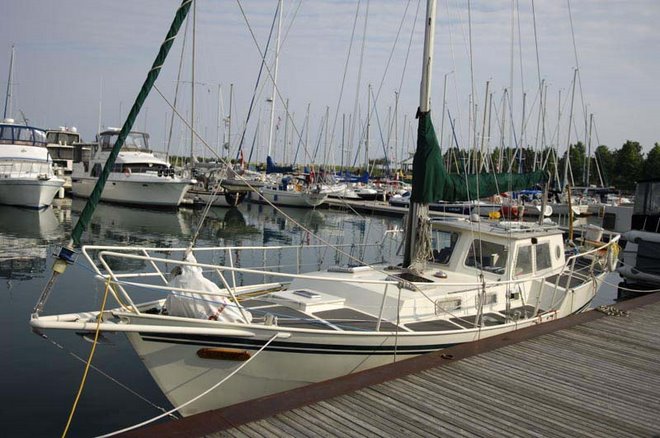On the way down to the club, I had what I thought was the rather clever idea of not using my possibly uninflatable and small and wobbly and elderly Zodiac as a platform from which to do the fairly extensive measuring and drilling and grinding required, but instead to use one of the club's Boston Whaler-type boats...flat, heavy and stable like a raft, but a raft with an outboard. This proved to be the best idea of an admittedly unambitious week, inspiration-wise.
Peter, the vane's designer, builder and primary installer, seemed to appreciate being able to drop things without hearing splashing, a real change from the usual outcome, apparently. Quick access to my horde of obscure if essential tools smoothed the mood of all, as well. The 25-knot north-east gusterlies, less so.
First off was figuring out if the measurements I'd supplied and the modifications they'd performed made any sense whatsoever when confronted with the steely, baby's-got-back stern of Madame Alchemy. Mostly, they did.
This was followed by lots of drilling and, when it was found that the servo-pendulum bit would graze the ambitiously designed if materially superfluous tiller head, quite a bit of grinding in which yours truly did some mischief (to a good end, however...). Further and better smoothing will be required, as will a "final fitting" in which the vane is taken off, the mounting boltholes primed and perhaps "bushed", and the various moving bits kept from corroding with the wax from the ring used to keep toilets from leaking. Think "Tufgel" at 0.001% of the price, and easier than squeezing a sheep.
Peter does final assembly of the vane. There's a few blocks and a tiller lock to put it (the tiller lock they brought committed suicide by drowning, but I know some men with face masks that might perform some "retrieval"), but when we finally get the stick in, we will have the ability to self-steer using zero amps. Peter's product isn't cheap (neither is the electric type of autopilot, nor are most things in the "presumed rich" world of boating), but it's stoutly made and custom-manufactured, and I think it will see several tens of thousands of nautical miles of use when we head for the horizon in a couple of years.
The vane will stay on until we a) put in the mast, b) restore the overhauled engine after having c) redone the water tankage and d) redone the fuel system and tankage OR e) designed and installed an arch-bimini thing that will both shade the sailing helm and support (eventually) an array of solar panels without interfering with the operation of the wind vane.
Which is why a wind vane went on an otherwise engineless, mastless, going nowhere, half-dead and partly dissembled boat today. It. Is. Necessary.








